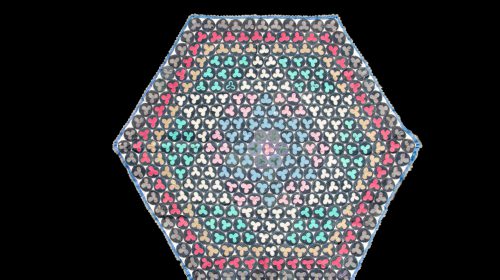The colorful wool penny rug was handmade by Jane Burrus Beisher (1865–1951) who, with her husband Peter, had a farm and summer boardinghouse in Greene Township. It dates from around the turn of the last century, and is a testament to Jane’s thriftiness, artistry and fine needlework.
Penny rugs became popular around the time of the Civil War, when women designed decorative mats using scraps of wool from blankets and old clothing. They were named penny rugs because they were made of two or three different sized circular medallions layered on top of each other. The top medallion was typically the size of a penny—in the 1800s pennies were larger than they are now—and sometimes pennies were actually sewn into them to help weight them down and make them lie flat.
Jane Beisher’s penny rug used a simple trefoil design on a two-inch circular medallion, and blanket stitches were sewn around each small piece using wool yarns. Through her use of contrasting colors, she created geometric designs in the shapes of circles, equilateral triangles, and six-pointed “Moravian” stars. The rug has a scalloped edging sewn all the way around with blanket stitching. It is backed with a tan color fabric in lightweight wool.
Showing light wear, it was probably more decorative than practical. Perhaps it was laid across a Victorian parlor table…or spread on the back of an arts-and-crafts settee…or draped over a high blanket chest. However it was displayed, it added a warm and cheerful touch to the Beisher home.
